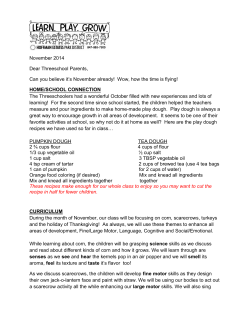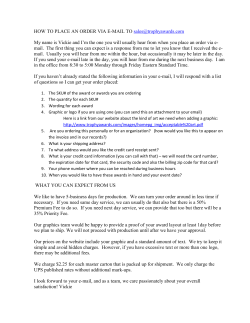
English - Specimen paper 2 - Mark scheme - 2014
Cambridge International Examinations Cambridge Primary Checkpoint ENGLISH 0844/02 For Examination from 2014 Paper 2 1 hour SPECIMEN MARK SCHEME MAXIMUM MARK: 50 This document consists of 9 printed pages and 1 blank page. IB14 0844_02_SP/3RP © UCLES 2014 [Turn over Section A: Reading Question number 1 Tick () two boxes that we know are TRUE from the passage. Part Mark 2 Total 2 Question number 2 Answer Further Information He wore a tweed suit. His mouth was wide. Award 1 mark for each correct tick. Why were the people in the district afraid? Part Mark 1 Total 1 Question number 3 Answer Further Information Because of the thunderstorm Accept responses referring to how loud / bright the thunder / lightning was / how violent the storm was What change took place in the scarecrow when lightning struck him? Part Mark 1 Answer Further Information Accept responses which refer to the effect the lightning had on the scarecrow He came to life. Answers must be from the text. Total 1 Question number 4 When Jack awoke, he stood up and looked around. Why? Part Mark 1 Total © UCLES 2014 Answer Further Information He / Jack had heard a voice / someone calling. Accept he/Jack had heard a noise. 1 0844/02/SP/14 3 Question number 5 Did the scarecrow seem calm? Give a reason from the text to support your answer. Part Mark 1 Answer Accept ‘No’ as an answer with one of Do not accept answers where the following phrases: ‘Yes’ has been ticked. • • • • Total 1 Question number 6 Further Information He was shouting He was waving wildly He was yelling He was leaning over at a crazy angle Accept answers that describe the scarecrow’s ‘behaviour’. Although scarecrows don’t usually talk, Jack decided to go and help the scarecrow. What does this tell you about Jack? Part Mark 1 Total © UCLES 2014 Answer Further Information That he is brave / curious / courageous / inquisitive Accept: kind / obedient/ courteous 1 0844/02/SP/14 [Turn over 4 Question number 7 Do you feel worried about Jack approaching the scarecrow? Explain your answer using words and phrases from the text. Part Mark 2 Total 2 Question Number 8 Answer Further Information Explanation – 1 mark Quotations – 1 mark Yes: the scarecrow might be dangerous / mad. ‘It isn’t every day you find a scarecrow talking to you’ Yes: he might be going crazy ‘He looks madder than I feel.’ Yes: he might be in danger ‘It isn’t every day you find a scarecrow talking to you.’ No: because he is a brave boy ‘Jack was curious’ No: the scarecrow is not dangerous / frightening ‘Jack was curious’ There is no mark for the first part of the question but answers must agree with the choice ‘Yes’ or ‘No’. Award one mark for each part of the answer. Accept other suitable reasons but it is important that explanations and quotations ‘match’ each other. Why did Jack jump away when the scarecrow’s leg twitched in his hand? Part Mark 1 Total © UCLES 2014 Answer Further information • Because scarecrows don’t usually move • Because he was frightened (to feel Accept answers that give a the scarecrow move) clear indication of Jack’s surprise / fear / disgust. • Because he didn’t expect to feel the scarecrow move • Because he was surprised 1 0844/02/SP/14 5 Question Number 9 What do you think the weather was like outside when Jack woke up? Give evidence from the text to support your answer. Part Mark 2 Total 2 Question Number 10 Answer Further information Award 1 mark for a suitable quote that matches the first part of the answer. • The storm had cleared away. • Colder than ever • He shaded his eyes Accept answers which mention the clearer day / cold in some way / that the storm had cleared. Who do you think is the point of view character in this story? Explain how you know. Part Mark 2 Answer Further information Award 1 mark for identifying a character: • scarecrow • Mr Pandolfo’s scarecrow • Jack Award a further mark for answers which give supporting information from the passage. Do not accept ‘Mr Pandolfo’ for the first part of the question. e.g. (scarecrow) we follow everything that he does (Jack) we know about his feelings. Total © UCLES 2014 2 0844/02/SP/14 [Turn over 6 Question Number 11 (a) Tick () one box to say which technique is being used here. (b) Explain what you think the underlined phrase means. Part (a) Mark 1 (b) Answer Simile Further information There are 2 ideas here: sound / what you see 2 Total 3 Question Number 12 Award 1 mark each for responses referring to: • the sound of the thunderstorm • the appearance of the thunderstorm 1 mark for suggesting a warlike / violent situation. Only award 2 marks if responses mention both sound and what is seen. (a) From the evidence in this extract which genre do you think the story is? (b) Name two general features of the genre you chose for 12(a). Part (a) Mark 1 (b) © UCLES 2014 Further information Fantasy Features of fantasy stories include: 2 Total Answer • The characters could all be real people in an imaginary setting. • The characters could be imaginary, perhaps with human characteristics. • The events could not actually happen. • The story can have a contemporary setting or be set in the future or past. 3 0844/02/SP/14 Award 1 mark for each correct answer. Answers which are correct in addition to those suggested can be awarded the mark. If the wrong answer has been given in part (a), accept any correct features of the genre that has been identified. 7 Section B: Writing 13 Now continue the story yourself to explain what the chief scientist discovers about the creature. Notes to markers • Marking should always begin from the lowest mark in each column, i.e. from 1 mark and work upwards. Award 0 if 1 mark is not achieved. • All the statements should be achieved for a student to achieve the mark (i.e. if there are two statements to describe a mark, both statements must be achieved before the mark can be given). • Stop marking at the first statement in a column that the student fails to achieve and award the mark in the box below. NB: MARK SCHEME FOR WRITING IS SPREAD ACROSS 2 PAGES. © UCLES 2014 0844/02/SP/14 [Turn over © UCLES 2014 Suspense, or excitement, where used, is well built. 4 During the course of the story, the development of the character(s) is shown through actions and reactions. 5 Character is well described with actions linked to key events. Imaginative details developed using a variety of techniques e.g. imagery. CONTENT A clear, consistent relationship between writer and reader is established and controlled. PURPOSE AND AUDIENCE 4 4 There may be appropriate links between paragraphs. 0844/02/SP/14 Sentences are mostly grammatically correct. 4 A wider variety of connectives is used appropriately, e.g. ‘if’, ‘when’, ‘because’. Range of connectives may be developed, e.g. ‘although’, ‘meanwhile’. 5 Complex sentences used to create effect using expanded phrases and clauses to develop ideas; e.g. noun, adverbial, adjectival and verb phrases. Dialogue is laid out correctly, with a new line for each speaker. 5 Paragraphs are used to help structure the narrative. Some use of complex sentences is controlled, including the position of clauses to focus attention. SENTENCE STRUCTURE Paragraphs are used to structure the narrative e.g. there is an appropriate build up and resolution of the main event. TEXT STRUCTURE 8 4 There may be some mistakes where certain more complex devices are used, e.g. colons, semi-colons, ellipses, brackets. Clauses are generally marked accurately by commas. All punctuation is used accurately, including speech punctuation. PUNCTUATION VOCABULARY Spelling is mostly accurate, including words with complex regular patterns. Allow plausible attempts at tricky polysyllables e.g. realised, interesting, wonderful, position, immediately. SPELLING 4 2 The reader is given basic information that is relevant to the narrative. 1 1 3 2 The writer gives sufficient information for a reader to understand the contents / events described. Some attempt to engage reader. The reader is engaged by the inclusion of appropriate detail. The reader’s response to different parts of the story is well controlled. Story ideas are evident. Openings and closings sometimes evident. 1 2 3 Some attempt to sequence ideas logically; e.g. content clear Ideas are organised simply with a fitting opening and closing that are mostly logical. Paragraphs used to sequence ideas but not consistently. 9 ‘and’ may be used to connect clauses. 1 2 Simple sentences are generally grammatically correct. Connectives are simple, e.g. ‘and’, ‘but’, ‘so’. 3 Some variation in sentence openings, e.g. not always starting with the same noun, pronoun or other word. Use of past and present tense is generally consistent. Some complex sentences are used to extend meaning but not always successfully. Straightforward sentences are demarcated accurately; e.g. full stops, capital letters, question and exclamation marks. Speech marks, if used, may not be accurate. Sentences nearly always demarcated accurately with full stops, capital letters, question and exclamation marks. 1 2 3 Speech marks, if used, are accurately placed around words spoken, although other speech punctuation may not be accurate. Commas are always used in lists and sometimes to mark clauses. Simple generally appropriate vocabulary used – limited in range but relevant. 1 2 3 Some evidence of deliberate vocabulary choices used accurately. Vocabulary is used effectively to create a strong image. e.g. use of simile or metaphor. Use of adventurous and precise vocabulary, including the use of figurative language where appropriate. © UCLES 2014 0844/02/SP/14 Award 0 where performance fails to meet the lowest description. Stop marking at the first statement in a column that the student fails to achieve and award the mark in the box below. The story has a simple plot. One event is described. Narrative viewpoint is established comfortably within the given genre (or ‘chosen’ if not given); e.g. the given story is fantasy or science fiction but genre could change with subsequent story as per instructions. 3 The story is well placed in its setting. e.g. not given but must be clearly evident. The story is concluded successfully and without rushing. Story is well crafted and focuses on either character or action. Spelling of high frequency words is generally correct. 1 2 3 Spelling of common words with more that one syllable, including compound words, is generally accurate. Correct spelling of polysyllabic words that confirm to a regular pattern. e.g. making, probably, clapped, possible, possibly. 10 BLANK PAGE © UCLES 2014 0844/02/SP/14
© Copyright 2025
















